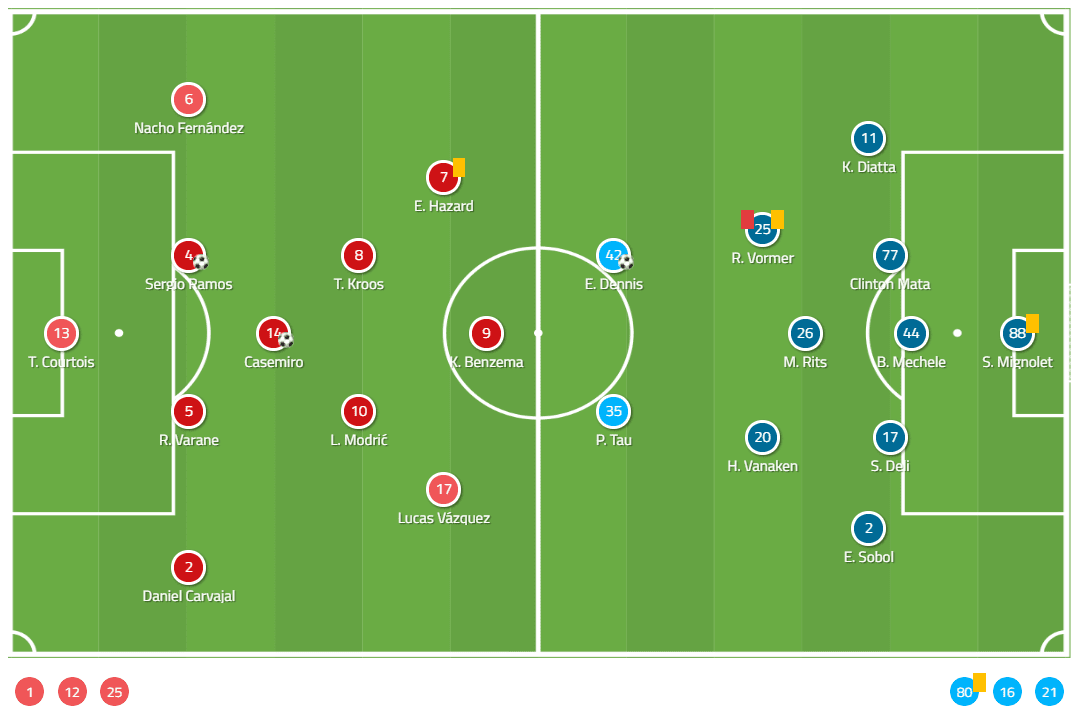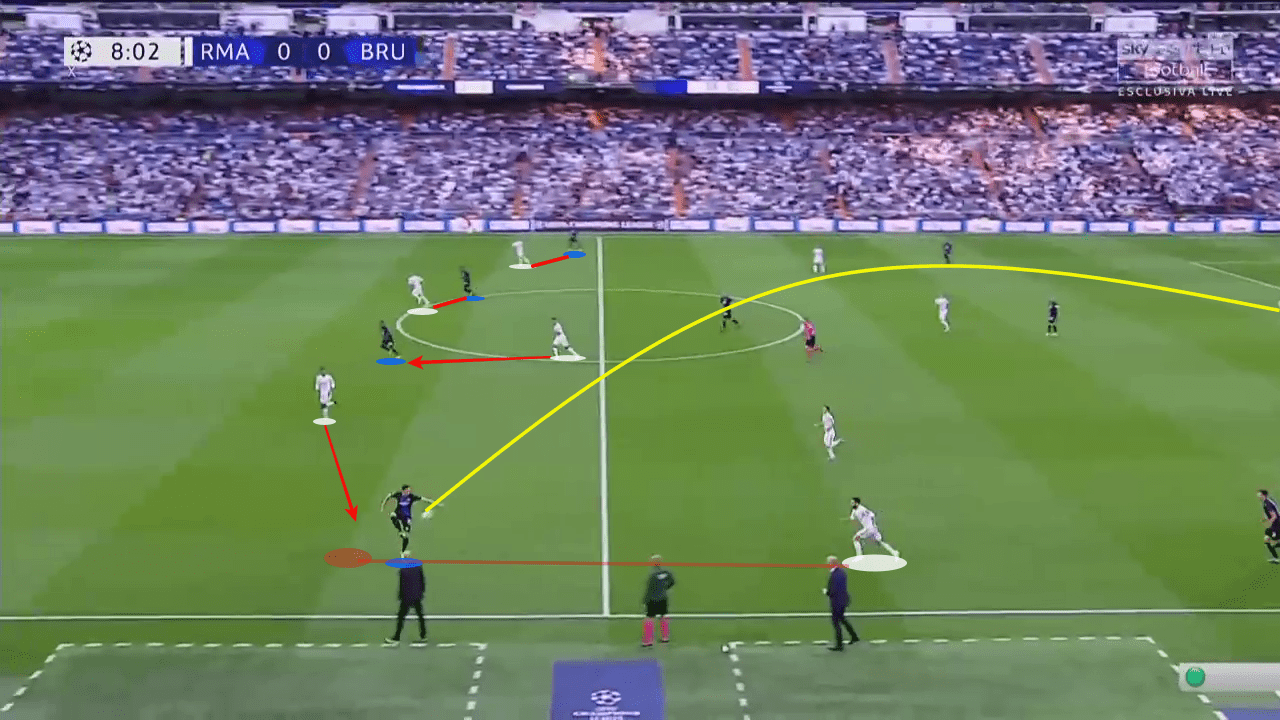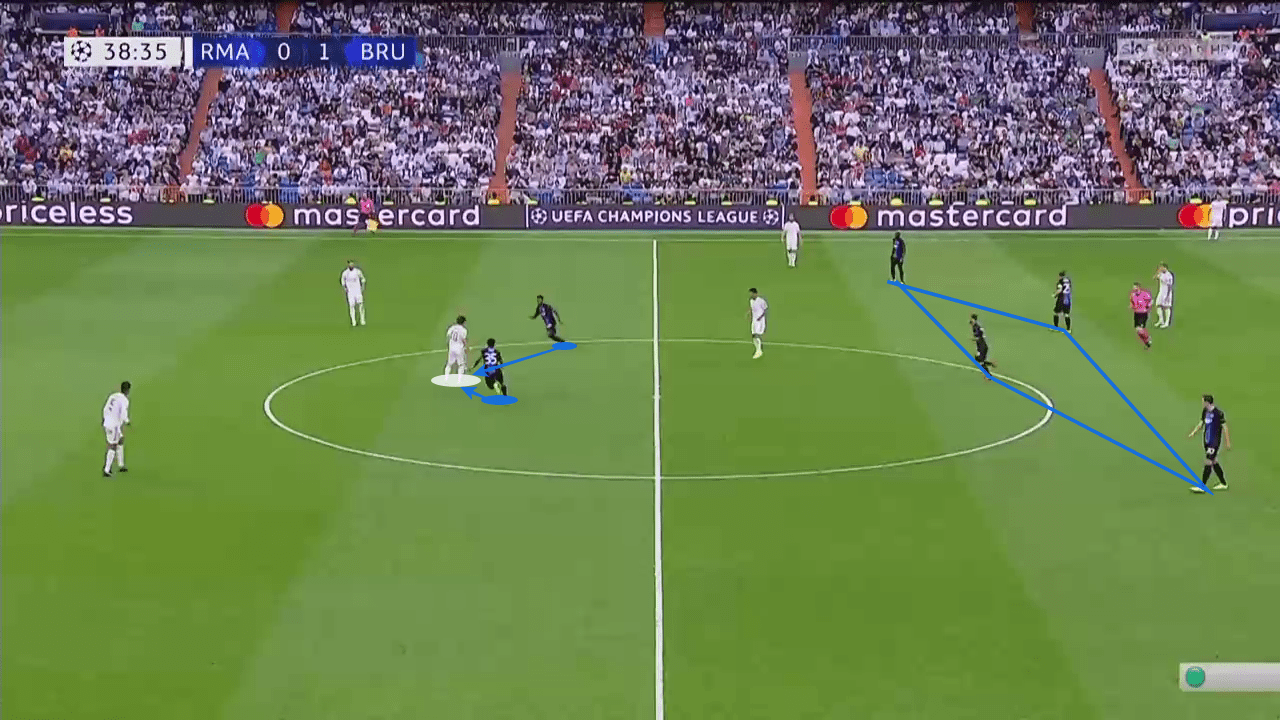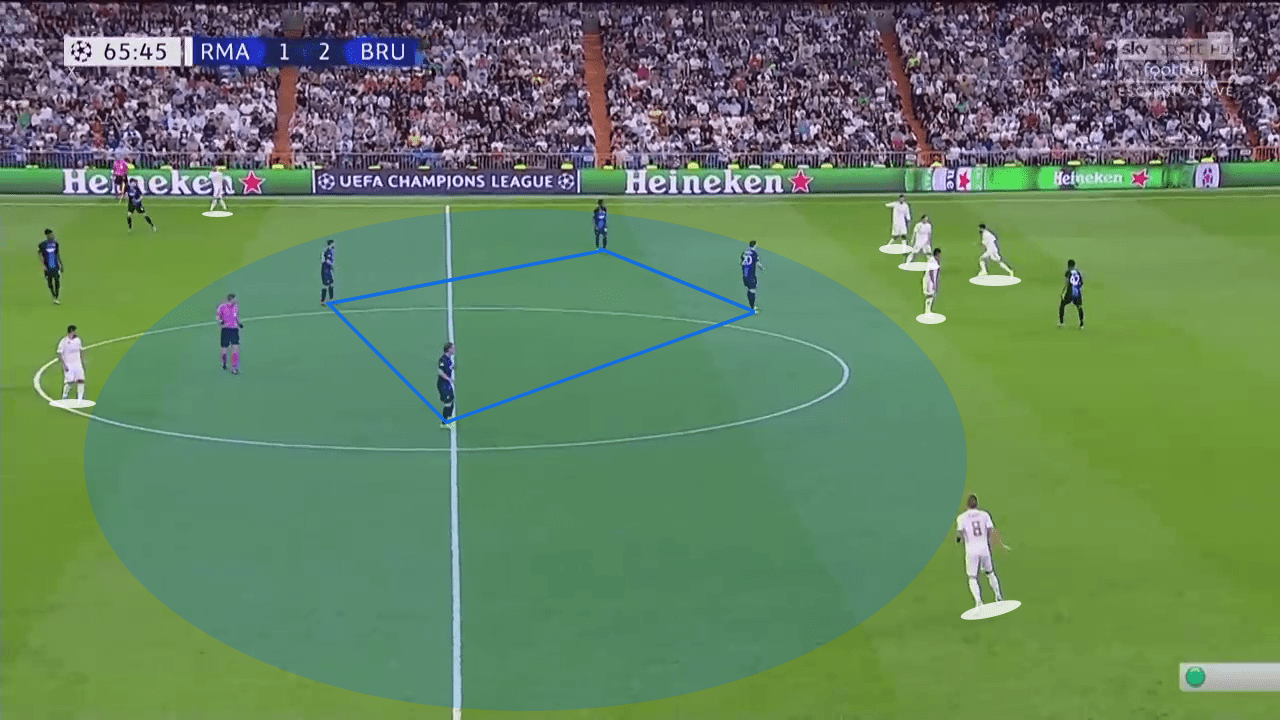After a defeat to Paris Saint-Germain in the first game of the group stages of the UEFA Champions League, Real Madrid were out for all three points against Club Brugge but ended up being lucky to walk away with one.
Real Madrid conceded early on as Club Brugge pounced on the counter with Dennis clumsily turning the ball beyond a sprawling Thibaut Courtois. He added a second before half-time, again on the counter, but it wasn’t enough as Sergio Ramos and then Casemiro secured far-post headers to level the scoreline later on.
This tactical analysis will consider the tactics deployed by both Zinedine Zidane and Philippe Clement as they fought out in this entertaining draw in Champions League action.
Line-ups

Zidane opted for his preferred 4-3-3 shape, with Luka Modrić returning and Lucas Vázquez getting the nod in attack while Gareth Bale was rested. The only real surprises came in that Zidane did not opt to rest more regular players.
Clement looked to adjust his set-up with a back-five deliberately designed to deny space for the Real Madrid front three. The midfield three took on Real Madrid’s perfectly whilst Dennis and Percy Tau provided pace in attack to allow a rapid counter-attacking system.
Gaping holes in the Real Madrid defence
Real Madrid’s defensive system has been concerning for some time, but Club Brugge expertly identified how to exploit the weaknesses that they left behind. The first goal was the perfect illustration of that. Dani Carvajal burst forwards without any need to take risks, but as soon as possession turned over, Club Brugge looked to play the long ball over the top into the acres of space that he had left behind. That immediately pulled apart the Real Madrid defensive line, with Raphael Varane forced across to close down, but Casemiro not deep enough to cover him. The result was plenty of time and space for Dennis to break through.
This was an approach that Brugge used repeatedly, with 22.6% of their passes being long, many of them down the flank. With the two central forwards and then wing-backs or midfielders bombing on into the spaces left behind, it was a key way that Clement looked to identify the areas where Real Madrid were leaving vulnerabilities. Whilst this was not used so often after taking the lead as Clement became more reluctant to commit so many men forward, it was essential to deciding the course of the game.

What should concern Real Madrid is the way in which opposition of far inferior quality found it so easy to predict their vulnerabilities. Nacho was far more reliable on the left, but Carvajal once again committed basic errors in his positioning. Without the pace and flexibility that the midfield once had, there is no alternative but to leave gaps on many occasions and Brugge thoroughly took advantage of this.
The high press once Club Brugge sat deep
Understandably, after Club Brugge took the lead, they began to sit deeper. This more defensive mindset invited further pressure onto them and Real Madrid took advantage as they grew back into the game. However, Clement insisted on one key element of their set-up in order to maintain the pressure by ensuring that at least two men engaged the Real Madrid defence and holding midfield line at all times, usually alternating but then looking to press together when the ball moved centrally to add greater urgency.
This was the case for the second goal, when the front two of Dennis and Tau pressed Modrić high, with Dennis springing into action as soon as he turned under pressure from Tau. Unusually for the Croatian, he lost his cool and possession, with Ramos poorly positioned to intervene following the turnover in possession. Positioned so closely to the midfielder, he offered no viable passing line and was almost immediately removed from the game when trying to stop the onrushing Dennis.

In total, 12.2% of Brugge’s defensive duels came in the Real Madrid half, with a 76.9% success rate, compared to 59.9% across the field on average. The high press worked wonders for Brugge and Real Madrid struggled to match their intensity. Attitude questions will once again be brought about, but it was clear from the kick-off that the visitors were more motivated for this game. There is no greater demonstration of that fact than the statistic that shows that Brugge were involved in almost twice as many defensive duels as Real Madrid.
A void in the middle
That press was maintained throughout, but also helped to break up the Real Madrid midfield from attack. A fundamental problem in their build-up play came in how the midfield and the attack became so distant with very little connection between them. That prevented any kind of build-up play or flow to their game, robbing them of the chance to gain momentum even in spite of making more than three times as many passes as their opponents and boasting 73.4% possession.
Of Real Madrid’s top 10 passing combinations, only one of them connected the midfield and the attack, with that link being Toni Kroos and Eden Hazard. As can be shown in this image below, Casemiro and Modrić dropped far too deep, almost forming part of the backline, whilst Kroos would spread himself wide in the attempt to find space. The Brugge midfield diamond capitalised to dominate that space and prevent any of the Real Madrid midfielders from making progressive runs through the middle with a four-man shield.

Given that over 51% of Real Madrid’s passes were backwards or lateral passes, compared to just 32.7% in a forwards direction, it is clear to see why the side were struggling to link between midfield and attack. Alongside Brugge’s midfield structure providing an obstacle, Real Madrid failed to provide the basics of movement in the middle of the park to outmanoeuvre them. With Kroos, Modrić and Casemiro all finding that time is against them, Zidane must open his eye to more mobile alternatives which can help to disrupt organised and rigid midfield structures which block the middle of the park.
Conclusion
This analysis has again reflected the disorganisation in Real Madrid’s set-up. Defensively and in midfield, there are major struggles though they are struggling to shine in attack too. However, any analysis of this clash must also award great praise to Club Brugge, who identified Real Madrid’s vulnerabilities and looked to focus on them from the off. Their organised defending prevented Real Madrid from playing their own game whilst they looked to set them on the back foot from the start. Clement won the point at the Estadio Santiago Bernabéu, but he could easily feel that it was two points dropped against Zidane’s men.

If you love tactical analysis, then you’ll love the digital magazines from totalfootballanalysis.com – a guaranteed 100+ pages of pure tactical analysis covering topics from the Premier League, Serie A, La Liga, Bundesliga and many, many more. Buy your copy of the September issue for just ₤4.99 here





Comments